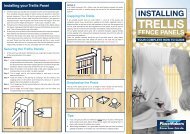Working with concrete. - PlaceMakers
Working with concrete. - PlaceMakers
Working with concrete. - PlaceMakers
You also want an ePaper? Increase the reach of your titles
YUMPU automatically turns print PDFs into web optimized ePapers that Google loves.
Mixing your own <strong>concrete</strong><br />
There are four basic elements involved in mixing <strong>concrete</strong>:<br />
1. cement,<br />
2. fine aggregate such as sand,<br />
3. coarse aggregate such as crushed rock or gravel,<br />
4. water for mixing the ingredients to type of paste or<br />
sloppy mix.<br />
The aggregates can be bought ready graded as 'builders<br />
mix'. All aggregates used should be free of organic matter.<br />
Water for making <strong>concrete</strong> should be clean, free of acids,<br />
alkalis, oils and sulphates.<br />
The ingredients in <strong>concrete</strong> are always the same, but results<br />
depend largely on the proper mix of the four elements. The<br />
intended use of the <strong>concrete</strong> will determine their proportions.<br />
If you are pouring heavy footings for walls where<br />
waterproofing is not a requirement, your mix can be 1 part<br />
cement to 6 parts builders mix.<br />
For paths, steps and driveways use 1 part cement to 5 parts<br />
builders mix.<br />
You can measure the ingredients on small jobs <strong>with</strong> a<br />
bucket.<br />
Always follow the instructions on the cement bag when<br />
mixing <strong>concrete</strong>.<br />
Add water to the ingredients to achieve a pliable or plastic<br />
mix of <strong>concrete</strong>.<br />
Concrete admixtures are available at <strong>PlaceMakers</strong> to help<br />
make the <strong>concrete</strong> easier to work <strong>with</strong>.<br />
A very sloppy mix will result in weak <strong>concrete</strong> and a poor<br />
surface which is likely to be dusty when cured.<br />
Calculate the Volume of <strong>concrete</strong> required<br />
1. Multiply the length by the width. This gives the area<br />
in square metres. (eg: Your drive is 24 metres long<br />
and 2.4 metres wide and you need it 75mm (0.075m)<br />
thick).<br />
(eg.24 x 2.4 = 57.6 M 2 ).<br />
2. Multiply the square metres by the thickness in metres.<br />
(eg. 57.6 x 0.075 = 4.32 M 3 ).<br />
This gives the volume of <strong>concrete</strong> required, in cubic<br />
metres.<br />
Fig 1<br />
2
















